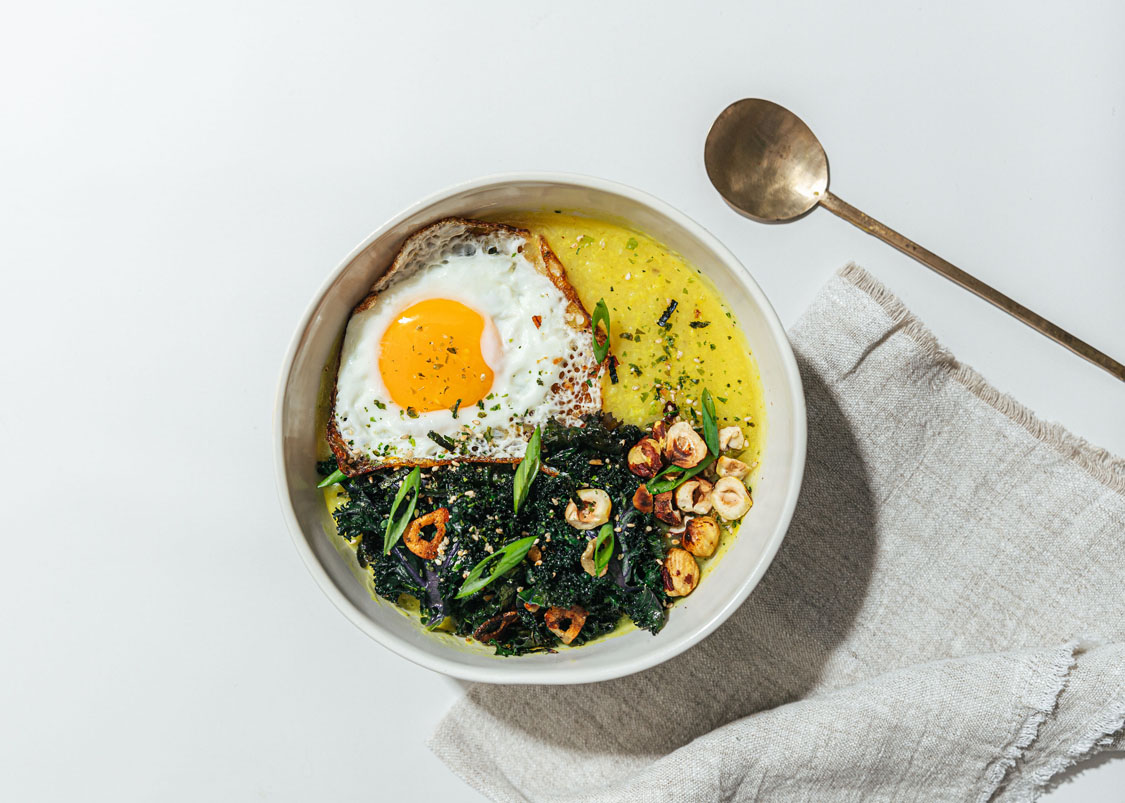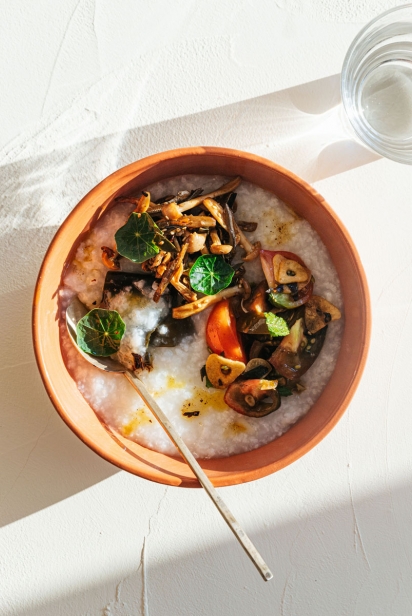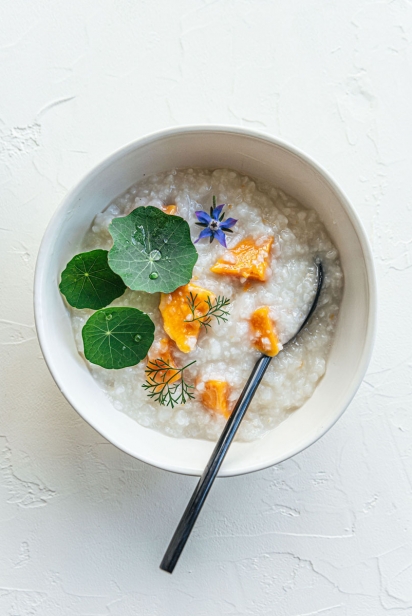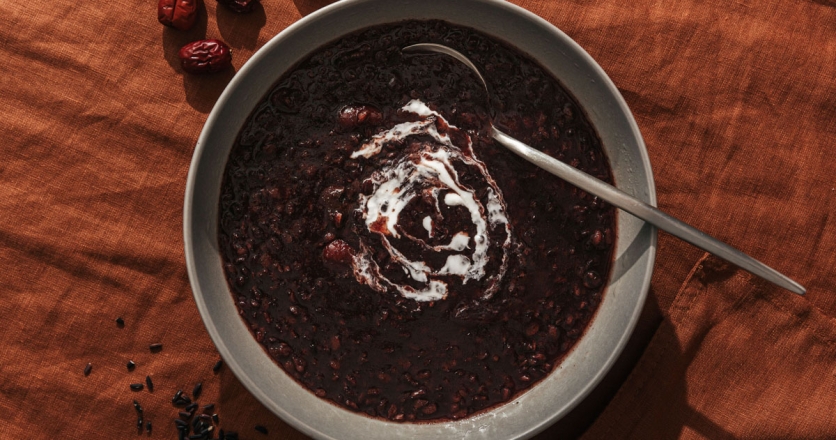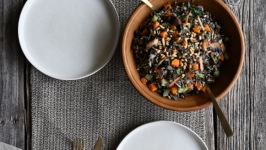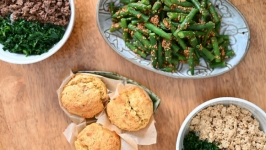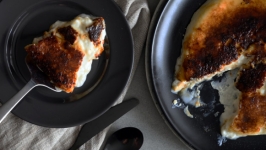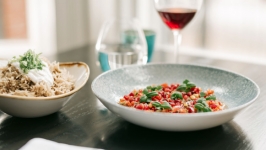The Comfort of Congee
For many Asian families, congee is the epitome of comfort food. Food is memories, food is medicine, food is a love language passed from generation to generation. In Taiwan, we eat congee on many occasions — when we get the flu, when the weather is cold, when we’re homesick or when we’re hungover. It’s available at most breakfast shops, topped with a stick of salty donut, pickled vegetables and green onions, served with a cup of fresh soy milk to wash it down. We even have designated restaurants for congee called “清粥小菜” meaning “light congee, little dishes.”
Every Asian country has its own version — Japan, Korea, the Philippines — but the Cantonese shine with their creative versions of savoury and sweet congee. In Taiwan, root vegetables such as sweet potato and taro, and proteins such as century egg and pork are often added for taste.
For those new to congee, it’s basically rice, boiled in stock or water many times its weight until the rice breaks down and becomes a thick, white porridge. It’s a dish consumed every day and during festivals by villagers and emperors alike. The ways to eat congee are endless. The common one is a bowl of unsalted rice porridge to go with any topping you have on hand. Popular toppings range from pickled vegetables, eggs (poached, fried, scrambled and preserved), chili oil, pork floss (dried and flaked pork), tofu braised in five-spice, soy sauce and brown sugar.
The health benefits of congee are numerous. It aids digestion and boosts one’s chi or “vital energy.” Depending on what base and toppings you use, there are combinations that, according to Chinese medicine and family wisdom passed on for generations, are used to cure ailments and keep you in good health. Millet is an ancient grain that aids digestion. Mung beans are said to detox and cool the body. Adzuki beans are particularly good for women — they warm the body and help replenish blood. Black beans are calming and nourish the kidney. Garlic and ginger aid digestion and support the gut. Red beans offer a warming winter soup and jujube dates are the most popular ingredient for those looking for general health benefits.
Here is a basic Chinese congee recipe to get you started.
Basic Chinese congee
Serves 2 to 3
This is a simple stovetop recipe for Chinese congee. One thing to remember is the 1:10 rice to water ratio. For a thicker consistency, use 8 cups of water. For runnier congee, use 12 cups. And if you're like me, make something in between.
1 cup white rice, rinsed until the water runs clear
10 cups water or stock of choice
1-inch knob of ginger, peeled and thinly sliced
2 whole cloves of garlic, peeled
½ teaspoon kosher or sea salt, or more to taste
To a large pot over medium heat, add stock, rice and ginger. Bring the mixture to a boil, then reduce the heat to a low simmer. Stir occasionally so the rice doesn’t burn at the bottom.
Simmer the congee for about 1 hour or until the congee is thickened and creamy. Add salt to taste. Serve straight from the pot.
Cooking tips
Choose starchy, short-grained rice. I like jasmine for the flavour; basmati will be on the dry side.
It’s important to add all the water at the beginning, which will result in a smooth, creamy congee. Don’t throw out the rice gruel that rises to the top during the cooking process. It is said to be good for upset stomachs and the flu.
Congee thickens as it cools. If not consumed all at once, add stock or water to create the desired consistency.
Sweet potato congee
Serves 2 to 3
This sweet potato congee is a classic recipe in Taiwan. The map of Taiwan is shaped like a sweet potato and the Taiwanese take pride in what we call our “sweet potato spirit,” meaning a spirit determined to take root and bear fruit wherever we are planted. The whole sweet potato plant is edible, from the roots to the shoots, and known to boast many nutritional benefits.
This recipe is mild, and most commonly served with savoury items for breakfast.
1 cup rice (short grain or jasmine)
10 cups water
1 medium-sized sweet potato
Rinse 1 cup of rice until the water runs clear. Soak for 1-houror overnight. Drain and set aside.
Peel and chop 1 medium sweet potato into 1-inch pieces. Set aside.
Bring 10 cups of water to a boil, add the rice and bring to a boil again. Adjust the heat to simmer and cook for 45 minutes to 1 hour. Stir regularly to prevent it from sticking to the bottom of the pot. Cook until the rice is soft, but still retains its shape.
Add the sweet potato and bring it to a boil for 5 minutes. Cover the pot with a lid, turn off the heat and let it sit for 20 minutes. The heat from the rice will cook the sweet potato while keeping its shape. Don’t let it get mushy.
Serve and enjoy the congee while it’s hot. It keeps in the refrigerator for 2 to 3 days.
Breakfast topping ideas: fried egg, ramen egg, vegetable pickles, furikake, roasted peanuts or nuts, spicy chili oil, savoury stir-fried or sautéed greens.
Purple rice and coconut congee
Serves 2 to 3
This purple rice coconut congee is a stunning classic for all seasons. In summer, you’ll find this recipe chilled and served with a dollop of coconut cream at Chinese and Southeast Asian restaurants. In winter, it’s incredibly comforting served warm like a rice pudding. Chinese medicine beliefs say the stomach is an organ that likes to be kept warm. This winter dessert is perfect for that.
Purple rice replenishes chi and is rich in iron and minerals. Red jujube dates are added here more for nutrition than taste. Known as the beauty fruit of Asia, these dates are consumed daily and added to most soups. You can omit them if they’re not a pantry staple.
1 cup purple sticky rice (found in most Asian markets)
7 cups water
3 to 5 red jujube dates, rinsed
Rock sugar to taste (substitute cane or brown sugar)
Coconut milk, for serving
Soak the purple rice overnight in water. If you are in a hurry, soak in hot water for one hour. This will soften the grains and ensure an even cooking process.
In a medium pot, add the soaked purple rice and seven cups of water. Bring to a boil over high heat, then reduce the heat to a low simmer. Add the red jujube dates and simmer for one hour. In the last 20 minutes, stir regularly to prevent the rice from sticking to the bottom of the pot. The grains should easily break apart and have a porridge-like consistency.
Add the rock sugar to taste and stir to dissolve. Serve warm or chilled, with a generous dollop of coconut milk.
Cooking notes
The congee will thicken as it cools over time. If it becomes too thick, add water and adjust to your liking.


